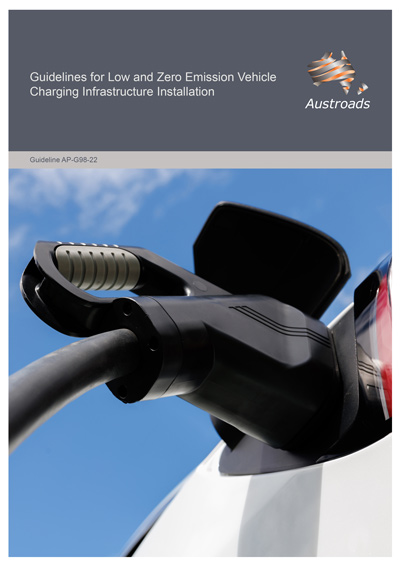Low and Zero Emission Vehicles

- Publication no: AP-G98-22
- ISBN: 978-1-922700-51-3
- Published: 14 September 2022
- PDF (free) Download
These guidelines cover the installation of charging infrastructure for Low and Zero Emission Vehicles (LZEVs), including requirements, location, usability, and design.
LZEV charging infrastructure is provided to encourage the use of LZEVs, and to help overcome “range anxiety”, particularly for vehicles travelling long distances.
The guidelines are designed to aid road managers, and to prompt consideration of issues relating to planning and design.
The document draws on work and guidance from across the member states and New Zealand, as well as international insights.
As this is a relatively fast-moving area of interest, Austroads will continue to monitor and research developments, with a view to updating these Guidelines on a regular basis.
For a detailed overview of the guidelines, watch a webinar with David Silvester and Norman Cheung.
- Summary
- Glossary
- 1. Introduction
- 1.1 Scope
- 1.2 Purpose of the Guidelines
- 1.3 How to Use the Guidelines
- 1.4 References
- 2. Overview
- 2.1 LZEV Charging
- 2.2 Use Cases
- 2.3 Checklist for the Installation of LZEV Charging Infrastructure
- 3. Planning
- 3.1 Site Selection
- 3.1.1 Urban Specific Considerations
- 3.1.2 Rural Specific Considerations
- 3.2 Planning and Environmental Approvals
- 3.2.1 Australia
- 3.2.2 New Zealand
- 3.3 Layout
- 3.3.1 Accessible Parking
- 3.3.2 Access for Maintenance Crews
- 3.3.3 Urban Specific Requirements
- 3.3.4 Rural Specific Requirements
- 3.4 Ingress and Egress
- 3.4.1 Urban Specific Requirements
- 3.4.2 Rural Highway Specific Requirements
- 3.5 Energy Supply
- 3.5.1 Rural Specific Requirements
- 3.6 Future Proofing
- 3.1 Site Selection
- 4. Design
- 4.1 Charger Type
- 4.1.1 Smart Charging
- 4.1.2 Charging Hardware
- 4.1.3 Plug Type
- 4.2 Road Marking, Signage and Wayfinding
- 4.2.1 Urban Specific Requirements
- 4.2.2 Rural Specific Requirements
- 4.3 Personal Safety, Security and Lighting
- 4.1 Charger Type
- 5. Interoperability
- 5.1 Protocols and Cyber Security
- 5.2 Data Collection
- 6. Operations
- 6.1 DC Charging
- 6.2 AC Charging
- 6.3 Safe Charging Practices
- 6.4 Payment Systems
- 6.5 Communications and Applications
- 6.6 Charge Security
- 7. Maintenance
- 7.1 Maintenance Planning
- 7.2 Monitoring
- 8. Decommissioning
- 9. Future Technology
- References
- Appendix A List of Standards and Guidelines
- A.1 Australia / New Zealand Standards
- A.2 International Standards
- Appendix B Checklist
- Appendix C Estimating Number of Charging Stations and Charging Bays
- C.1 Case Study 1 – Queensland
- C.2 Case Study 2 – New Zealand
- C.3 Capacity required
